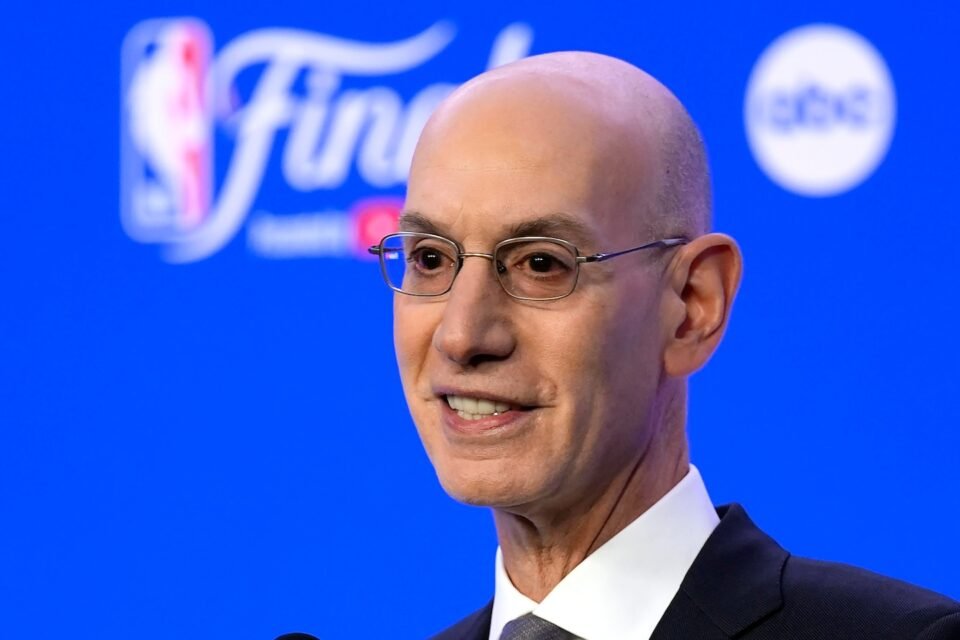Those decisions, among many others made since the NBA’s free agency period opened June 30, were shaped by a new collective bargaining agreement, which imposes steep financial penalties for adding talent upon the league’s highest-spending teams. Across the league, big-market teams such as the Warriors, Clippers, Knicks and Los Angeles Lakers took steps to avoid the “second apron” spending bracket for team salaries, which was set at $188.9 million for the 2024-25 season.
NBA Commissioner Adam Silver said Tuesday he is pleased with the early offseason returns, given the new salary cap system was intended to foster parity among the league’s 30 teams.
“The system appears to be working, in that we were very clear that we set out to put more pressure on the high-end [spenders],” Silver said following an NBA Board of Governors meeting in Las Vegas. “While we’re not looking to completely flatten salaries throughout the league, part of the goals we set in collective bargaining was to ensure that every team was in a position to compete for championships and had the resources available to do so.
“The second apron’s financial consequences are pretty severe, but [there is also] an impact on your ability to sign players and draft players. The teams are realizing there are real teeth in those provisions.”
To enter the second apron, a team would need to be well above the $140.6 million salary cap. Entering that zone forces a team to pay luxury tax penalties and lose the ability to use a midlevel exception, include cash in a trade and use trade exceptions obtained in the previous season. Additionally, a second apron team could lose the ability to trade certain future first-round picks or have its pick moved to the end of the first round.
If the Clippers had retained George on a contract similar to the four-year, $211 million deal he signed with the 76ers, they would have found it incredibly expensive to retain their existing rotation players and faced the new restrictions in trying to add talent around their core. Once George departed, the Clippers responded by adding Derrick Jones Jr., Nicolas Batum and Kevin Porter Jr. on smaller and shorter contracts that kept them out of the second apron.
The Clippers, who are owned by Steve Ballmer, the league’s wealthiest owner, were one of the NBA’s top three spenders in each of the past three seasons. This summer, they sacrificed George, a nine-time all-star, and ended his five-year partnership with Kawhi Leonard to preserve their future flexibility.
Similarly, the Warriors, who have won four championships since 2015, were the NBA’s top spender in each of the past four seasons. After deciding not to pay Thompson a lucrative long-term contract, Golden State filled in the gaps with budget-friendly additions such as Buddy Hield, Kyle Anderson and De’Anthony Melton.
“It’s still early days,” Silver said. “From what we want to see happen, we’re pretty happy.”
The NBA has long been a league built on dynasties — from Bill Russell’s Boston Celtics to Michael Jordan’s Chicago Bulls — but it has crowned a different champion in each of the past six seasons. Given the new challenges of aggregating and compensating several top players on the same team, the league’s newfound parity seems likely to continue.
The Celtics, who won the championship in June and will be a second apron team this season, could see their star-studded roster become prohibitively expensive as early as next summer. In other words, it will almost certainly be more difficult for the Celtics to dominate in the 2020s like Jordan’s Bulls did in the 1990s.
“As long as we can create something close to a level playing field in terms of the tools available to teams to compete, I’m absolutely fine with dynasties and I’m fine with new teams emerging every year,” Silver said. “What the fans want to see is great competition. For fans of whatever team they’re rooting for, they want to believe that their team, regardless of the size of the market or the depth of the pockets of ownership, are in a position to compete in the same way the 29 other teams are.”
One other immediate impact of the onset of the second apron era was a relative stagnation in star movement this offseason. Of the 26 players named all-stars in 2024, George was the only one who changed teams. That was a far cry from 2010, when LeBron James and Chris Bosh teamed up with Dwyane Wade on the Miami Heat, or 2016, when Kevin Durant joined Curry, Thompson and Draymond Green on the Golden State Warriors.
The new system is designed to more evenly spread superstars across the league. Unless top players follow Brunson’s lead and sacrifice tens of millions in annual salary, they will find it more difficult to engineer their own “superteam” configurations.
Brunson’s decision to sign a four-year, $156.5 million extension — far less than the five-year, $269 million he could have signed next summer — enabled the Knicks to trade for Mikal Bridges, re-sign free agent forward OG Anunoby and retain a roster that includes Julius Randle, Josh Hart and Donte DiVincenzo. Despite their savvy planning and Brunson’s big favor, the Knicks still have only two all-star players, and they lost center Isaiah Hartenstein to the Oklahoma City Thunder in free agency.
“I know reports have come out that the summer was boring from a fan standpoint,” Silver said. “I certainly don’t think it was. We still saw a lot of critically important players moving from one team to another as free agents. … While I don’t want [the new system] to be boring, I want to put 30 teams in a position to better compete. I think we’re on our way to doing that.”

